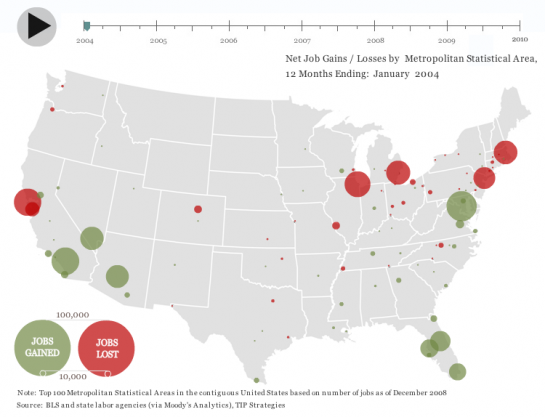While on the topic of job loss and unemployment, here’s an animated map from Tip Strategies that shows job gains and losses over time.
Red means loss and green means gain, and as you can see above, there isn’t much green (read that zero) on the map. The larger the circle is, the greater the number of net loss or gain compared to that of the numbers of the year before in the respective metropolitan statistical area.
Here’s what the map looked like in 2004:

[via The Big Picture | Thanks, Barry]

 Visualize This: The FlowingData Guide to Design, Visualization, and Statistics (2nd Edition)
Visualize This: The FlowingData Guide to Design, Visualization, and Statistics (2nd Edition)

There’s a fundamental problem in how the affected population is represented in these circles. If you take the legend as an example, the diameter of the 10,000 person size circle is maybe 1/8th (conservatively) the diameter of the 100,000 person size circle. If that is the case, the actual area of the 100,000 person circle is 64 times as large as the 10,000 person circle, far overstating the difference in population sizes. To accurately show the difference of a factor of 10, the diameter of a should be 3.162 (the square root of 10) times larger than the smaller circle.
shoot, you’re right, i was too hasty in my post. they’re scaling diameter to show gain and loss when they should be scaling area. tsk.
These style graphs often annoy me because they don’t take into account the local population size. Of course LA, Chicago, and NYC lost more jobs than Detroit, they are several times larger (none however are approaching the 25% unemployment of Detroit). This figure doesn’t really given anyone an idea of where people are losing jobs, so much as where most people live.
Pingback: “The Geography Of Jobs” | Larry Ferlazzo's Websites of the Day...
The first comment hits my complaint. Tufte calls it the fallacy of the dollar bill — using area to depict a one-dimensional value. Still a haunting graphic when viewed in diameters. I live in Michigan so I am acutely aware of our leadership role in unemployment.